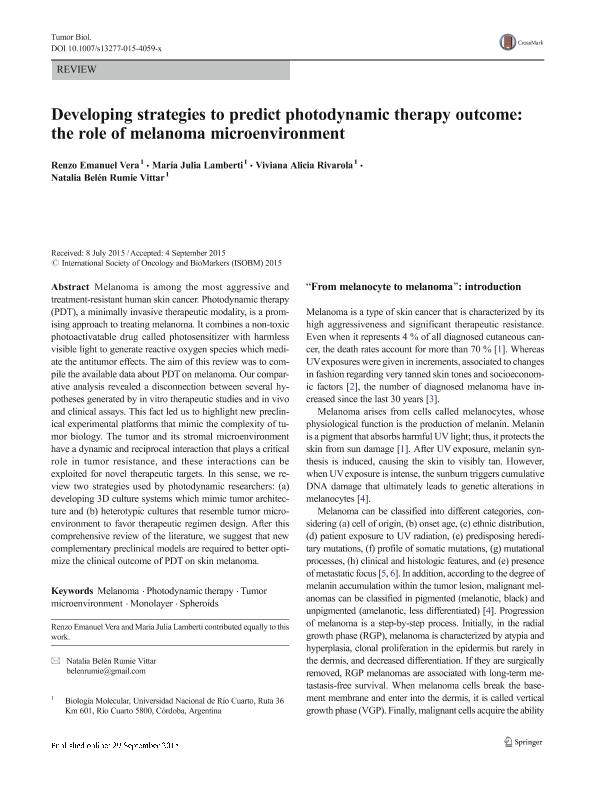Mostrar el registro sencillo del ítem
dc.contributor.author
Vera, Renzo Emanuel

dc.contributor.author
Lamberti, María Julia

dc.contributor.author
Rivarola, Viviana Alicia
dc.contributor.author
Rumie Vittar, Natalia Belen

dc.date.available
2019-02-22T21:31:47Z
dc.date.issued
2015-12
dc.identifier.citation
Vera, Renzo Emanuel; Lamberti, María Julia; Rivarola, Viviana Alicia; Rumie Vittar, Natalia Belen; Developing strategies to predict photodynamic therapy outcome: the role of melanoma microenvironment; Springer; Tumor Biology; 36; 12; 12-2015; 9127-9136
dc.identifier.issn
1010-4283
dc.identifier.uri
http://hdl.handle.net/11336/70757
dc.description.abstract
Melanoma is among the most aggressive and treatment-resistant human skin cancer. Photodynamic therapy (PDT), a minimally invasive therapeutic modality, is a promising approach to treating melanoma. It combines a non-toxic photoactivatable drug called photosensitizer with harmless visible light to generate reactive oxygen species which mediate the antitumor effects. The aim of this review was to compile the available data about PDT on melanoma. Our comparative analysis revealed a disconnection between several hypotheses generated by in vitro therapeutic studies and in vivo and clinical assays. This fact led us to highlight new preclinical experimental platforms that mimic the complexity of tumor biology. The tumor and its stromal microenvironment have a dynamic and reciprocal interaction that plays a critical role in tumor resistance, and these interactions can be exploited for novel therapeutic targets. In this sense, we review two strategies used by photodynamic researchers: (a) developing 3D culture systems which mimic tumor architecture and (b) heterotypic cultures that resemble tumor microenvironment to favor therapeutic regimen design. After this comprehensive review of the literature, we suggest that new complementary preclinical models are required to better optimize the clinical outcome of PDT on skin melanoma.
dc.format
application/pdf
dc.language.iso
eng
dc.publisher
Springer

dc.rights
info:eu-repo/semantics/openAccess
dc.rights.uri
https://creativecommons.org/licenses/by-nc/2.5/ar/
dc.subject
Melanoma
dc.subject
Monolayer
dc.subject
Photodynamic Therapy
dc.subject
Spheroids
dc.subject
Tumor Microenvironment
dc.subject.classification
Otras Ciencias Biológicas

dc.subject.classification
Ciencias Biológicas

dc.subject.classification
CIENCIAS NATURALES Y EXACTAS

dc.title
Developing strategies to predict photodynamic therapy outcome: the role of melanoma microenvironment
dc.type
info:eu-repo/semantics/article
dc.type
info:ar-repo/semantics/artículo
dc.type
info:eu-repo/semantics/publishedVersion
dc.date.updated
2019-02-22T18:59:33Z
dc.identifier.eissn
1423-0380
dc.journal.volume
36
dc.journal.number
12
dc.journal.pagination
9127-9136
dc.journal.pais
Alemania

dc.description.fil
Fil: Vera, Renzo Emanuel. Universidad Nacional de Río Cuarto; Argentina. Consejo Nacional de Investigaciones Científicas y Técnicas; Argentina
dc.description.fil
Fil: Lamberti, María Julia. Universidad Nacional de Río Cuarto; Argentina. Consejo Nacional de Investigaciones Científicas y Técnicas; Argentina
dc.description.fil
Fil: Rivarola, Viviana Alicia. Universidad Nacional de Río Cuarto; Argentina
dc.description.fil
Fil: Rumie Vittar, Natalia Belen. Universidad Nacional de Río Cuarto; Argentina. Consejo Nacional de Investigaciones Científicas y Técnicas; Argentina
dc.journal.title
Tumor Biology

dc.relation.alternativeid
info:eu-repo/semantics/altIdentifier/doi/http://dx.doi.org/10.1007/s13277-015-4059-x
dc.relation.alternativeid
info:eu-repo/semantics/altIdentifier/url/https://link.springer.com/article/10.1007%2Fs13277-015-4059-x
Archivos asociados
